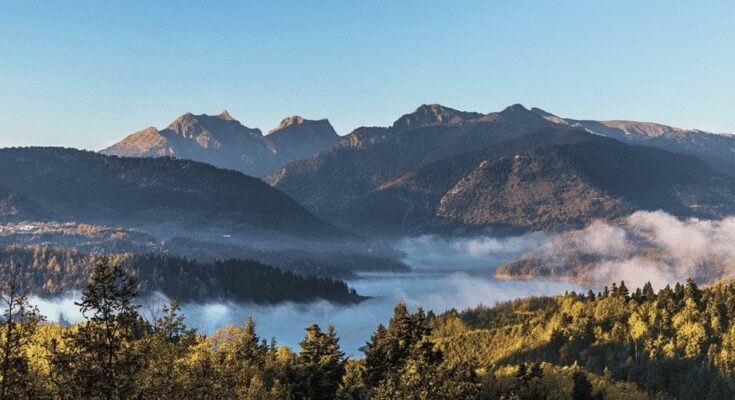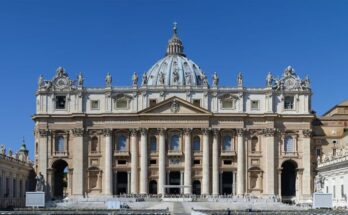
The following story is a tale of philoxenia (hospitality) and beauty in Greece’s Switzerland: the Agrafa mountains.
Vasilis Tsantilas, a former mayor of a municipality in the mountainous region of Agrafa in southern Thessaly, was met at a summer gathering. During conversation, Mr. Tsantilas extended an invitation to see the beauty of his homeland. Plans are often made at such events, only to be quietly buried later. This time was different. The invitation was made concrete, leading to a journey to Karditsa, the provincial capital of the Agrafa mountains.
Vasilis, who quickly became a familiar figure, is 67 years old, tall, slim, friendly, and very popular with the locals. The fact that he had been the chairman of the Agrafa Villages Association for 40 years opened all doors. He is proud of his homeland and wanted to showcase as much of it as possible within three days. Only a few of the many sights can be highlighted here, though a whole travel guide could easily be written about the region.
The Agrafa Mountains divide the south of Thessaly from the north of central Greece. The highest peak is Tymfristos, at 2,315 meters above sea level. The inhabitants live mainly from cattle breeding, and wine and honey production. The main attraction is the Plastiras reservoir lake, 810 meters above sea level. Although tourism is also important for the local economy, the area is not overcrowded and is considered an insider tip with only a small number of foreign visitors.
Exploring the heart of Agrafa, Greece

Exploration of the Agrafa region began in the Thessalian part with a visit to the archaeological museum in Karditsa. Housed in a chic new building, it presents finds from prehistoric times to the Byzantine period. The director of the museum, Mr. Vousaksakis, provided a professional and detailed tour, and conversations about individual exhibits developed here and there. The pride of the museum is a bronze statue of the god Apollo. A map shows the Thessalian part of the Agrafa with its monuments and archaeological sites.
During the drive to Mavromati, the birthplace of the Greek hero Karaiskakis, the meaning of the name “Agrafa” was discussed. Vasilis explained, “We were hardly affected by Turkish rule back then. We didn’t have to pay taxes and were therefore not registered in the occupiers’ tax registers. That’s where the name Agrafa comes from – the unregistered ones.”
After a brief visit to the Karaiskakis Museum, where the resistance fighters’ weapons and equipment were on display, the tour continued to the monastery of Agios Georgios.

The almost 1,000-year-old monastery is located very close to Mavromati. It presented a picturesque scene, with a young nun leading a herd of goats into the stables. In the monastery courtyard, the abbess Miriam and two of her sisters extended a warm welcome. Mother Miriam comes from Cologne and is the only German abbess of an Orthodox monastery in Greece.
In a shady spot commanding a beautiful view of the mountains surrounding the monastery she offered coffee and sweets, and shared the story of how she joined the monastery after her retirement and was elected abbess. She then gave a tour of her medieval church: the iconostasis is handmade, the wood blackened by soot from the candles and incense; wall paintings cover the entire interior. After some conversation about God and the world, warm farewells were said and a return visit promised.

On the way to Fanari Fortress the Chalili brothers’ restaurant, which you will find on the roadside before the village of Charma, provided refreshment: large portions of good-quality food, notably Tsalafouti, a regional starter made from sheep’s and goat’s milk.
The Fanari Fortress towers over the village of the same name. It was built in the 13th century. Unfortunately, a visit was impossible as the catastrophic rainfall in October 2023 had washed away the access road.
The first day of the trip concluded with a glass of wine in Karditsa, shared with Vasilis’ wife Charoula.
The next morning, the route continued to Mesonikolas. A visit to the Karamitros winery was on the agenda. Senior bosses Ioannis and Ioanna Karamitros present their treasures: champagne, tsipouro, and wines impressively displayed in discreetly lit wall niches, and a tastefully decorated small room for tastings. “Our son Georgios, who looks after the white wine production further down in the valley, is responsible for the decoration,” confided Ioannis.
An offer of wine tasting so soon after breakfast was laughingly declined, though the secrets of wine production were eagerly absorbed. The winery, with its huge, 10,000-liter stainless steel tanks, the bottling machine, and the wooden barrels in the two wine cellars, reveals the Karamitros family’s dedication to their craft. Notably, Chinese characters can be seen on two of the barrels which were bought by a Chinese couple and left on-site to mature further. The many certificates and awards for the Karamitros family’s wines are not on display, but kept piled up in boxes next to the bottling machine.

The wines have interesting names: Snob, Paradise Can Wait, Tales of Blood, The Lady of the Lake, etc. The visit ended with a few grapes picked from the pergola outside.
On the drive to Morfovouni (Pretty Mountain) Vasilis describes the characteristics of the Agrafiots: “We are friendly towards strangers, hospitable, patriotic, hard-working, and homely….we also hate getting into debt.”
In Morfovouni, the newly re-elected mayor of the municipality of Limni Plastiras, Panagiotis Nanos, welcomed the visitors at the mayor’s office. Conversation focused on tourism, with Mr. Nanos highlighting the region’s existing infrastructure, such as hotels, guesthouses, and restaurants. During his new term of office, beach resorts and campsites are to be built on the shores of Lake Plastiras, and the existing network of hiking trails is to be extended.
After the interview, Mr. Nanos showed an interesting project, an artists’ park which has been created on a hill near the village. The background is the events of the Second World War, when Italian and later German soldiers occupied Agrafa. Under the motto “Peace and Reconciliation,” Greek, Italian, and German artists have created works that can be admired in the open air.
Adventures in the Agrafa Mountains

A journey to the Plastiras reservoir lake followed, with frequent stops to admire the view and take photographs. The lake is over 13 km long, up to around four km wide, and covers an area of around 22 km². The dam was completed in 1962 and is over 80 m high. Its water is used to supply the towns of Karditsa and Larisa. Without the water of the lake, agriculture in the Thessalian plain, the breadbasket of Greece, would be inconceivable.
A colorful scene on the lakeshore near the village of Kalivia caught the eye, leading to a visit to Tavropos, named after a tributary of the reservoir. Here it’s possible to hire bicycles, water bikes, and canoes, as well as explore the lake on a catamaran or put your archery skills to the test.
Conversation with local staff revealed that the area experiences its peak tourist season during the winter months. The peaceful surroundings, with young tourists preparing for lake excursions and horses grazing quietly nearby, created a tranquil atmosphere.

Agrafa in Greece is made up of contrasts. Bare mountain ridges, mixed forests, and large lakes make the area attractive for vacationers in all seasons. After crossing the 200 m long dam wall the route led back towards the mountains and the “Agrafon” mountain hut, situated at an altitude of around 1,700 m.
Directly in front of the hut are large fir trunks waiting to be sawn and split. Winter is just around the corner. The hut was bustling with young people and friendly dogs (although it is not allowed to bring your own dog to the hut.) The finds of mushroom pickers were carefully checked for edibility using literature and the internet.

Some of the young Greeks wore T-shirts with the slogan “Save Agrafa” printed on them. This referred to a plan for wind turbines to be erected near the hut to generate energy, a project that meets with resistance throughout the area.
Vasilis expanded on the subject: the wind turbines would be installed not only near the mountain hut but also on the entire mountain ridge of the summit region. “This will spoil the beautiful nature and will certainly have a negative impact on tourism”, commented Vasilis.
The journey continued to the mountain village of Amarantos for a meeting with the local mayor, who is also the chairman of the local hiking association.
In Amarantos, the local inn had a cozy atmosphere reminiscent of pubs and taverns in England or Germany. Rustic furnishings, wood as far as the eye can see, beer glasses on the table—only the Greek music was different. Thomas, the landlord in a lumberjack’s shirt, grilled souvlakia in the open fireplace and served home-grown tomatoes. Mayor Antonis Papadokos discussed the region’s many hiking trails, including the European long-distance hiking trail E4.

The E4 runs through the mountains, but there are also circular hiking trails of various lengths and levels of difficulty. In addition to the flora and fauna, there are also plenty of old stone bridges to discover, for which the area is famous.
“It’s best to take a look at the website of the Karditsa Hiking Club. There you will find maps, trekking routes, and circular hiking trails. You can download the routes as GPX files onto your cell phone and navigate them safely,” Antonis explained.
The third day began with a visit to the acropolis of Kallithiro. A proud fortress once stood here, of which only the lower part of the outer walls and the towers remain. It was built in the 4th century BC and was inhabited until 27 AD.
The route continued along narrow country roads to the Smokovo reservoir, which is around 10 km long. The name comes from the Slavic inhabitants who once settled here. The reservoir is surrounded by a gently undulating landscape, where shepherds use the lush green pastures to graze their animals.

The Smokovo reservoir supplies the surrounding villages and towns on the Thessalian plain with water, and agriculture in particular benefits from it. It presents a magnificent sight, surrounded by forests and maquis, its waters glistening in the sunlight.
A drive back into the mountains towards Rentina provided a contrasting route. The road wound along the slope of a gorge for kilometers until it reached the Assumption Monastery, where the abbess welcomed the visitors and shared the monastery’s history, including its centuries-old wall paintings, valuable icons, a hand-carved iconostasis, and ivory inlay work.

Cultural discoveries and local traditions
The day concluded with a visit to the nearby church of Agios Nicholaos in Rentina, where Father Nicholaos provided a detailed tour of the richly furnished interior, culminating in a view of the glittering church treasure, securely protected behind locked doors.

The journey back to Karditsa included a stop at the thermal baths of Smokovo, where visitors can take a steam inhalation or a sauna, use the hammam bath, or enjoy the thermal waters.
Further conversation with a group of local young people, most of them wearing the ‘Save Agrafa’ T-shirts, revealed their deep concern about the prospect of the landscape being spoiled by wind turbines.
Finally, Nikos Manoukas, the mayor of the village of Kedros, showed the way to the folklore museum, where local guide Christina introduced the displays of tools and everyday utensils from various eras. A demonstration of traditional weaving by Meropi, an aged villager still able to operate the large hand loom, provided an engaging end to the tour. Meropi’s skill and pride in her work left a lasting impression.

The tour of Agrafa ended here, leaving behind a question: why do so few foreigners visit this authentic part of Greece, which for all its attractions still remains largely untouched by mass tourism? Visitors are sure to be impressed, and to feel at home among the welcoming people of Agrafa.



